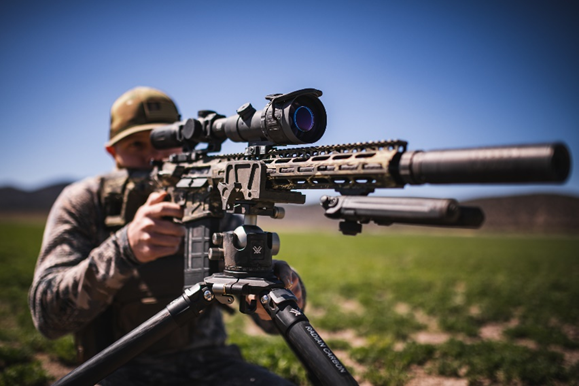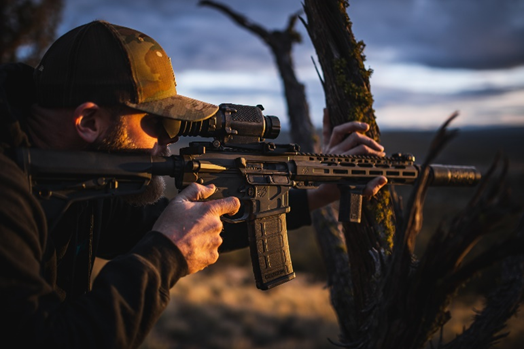Can Animals See Your Night Vision or Thermal Optics? Debunking Myths and Facts
Nov 1st 2024
Night vision and thermal optics are invaluable tools for hunters, wildlife observers, and outdoor enthusiasts, enabling clear visibility in low-light conditions. However, a common question arises: can animals detect these devices? This article explores whether night vision and thermal imaging are visible to animals, clears up misconceptions, and offers tips for remaining undetected in the field.

Figure 1: PVS14 + Sidekick Kit
Myth vs. Reality: Can Animals See Night Vision Devices?
Night vision devices, such as goggles and scopes, amplify ambient light (like moonlight or starlight) or use infrared (IR) illuminators to produce a visible image. One of the most persistent myths is that animals can see the glow from night vision devices, especially IR illuminators. Here’s the truth:
1. Infrared Spectrum and Animal Vision
- How Night Vision Works: Night vision devices detect infrared (IR) light, which is outside the range of human vision. Most night vision scopes and goggles use an IR illuminator, an invisible light source that enhances the device’s effectiveness in complete darkness. The (IR) light source operates in the invisible light spectrum of 750nm to 850nm outside a human or animal visual spectrum.
- Animal Sensitivity to Infrared Light: The vast majority of animals cannot see IR light because it falls outside their visual spectrum. Mammals, including deer and wild boar, cannot detect the infrared beams from (IR) Light sources which are used with night vision devices, but not always. As night vision is a passive system and can operate with just ambient (IR) light. This makes night vision especially effective for observing and tracking animals without alarming them.
While some reptiles, insects, and amphibians have limited infrared sensitivity, their detection range is typically short, and they’re less likely to react to IR in a way that would impact hunters or observers.

Figure 2: Night Vision Clip On CO-MR
2. Does the Glow from Night Vision Devices Affect Animals?
- Green/White Phosphor Display: Traditional night vision devices display images in shades of green or white, visible only to the user. This phosphor screen does not emit light outward and is, therefore, not visible to animals. The only visible light might come from a faint glow at the eyepiece, which is generally too subtle to alert wildlife.
- Precautions for User Detection: For maximum stealth, users can shield the eyepiece to prevent stray light, ensuring no visible light is emitted to alert animals.
Do Thermal Devices Alert Animals?
Thermal imaging works differently from night vision. Instead of amplifying light, thermal devices detect heat signatures (totally passive systems), creating an image based on the temperature differences in the surroundings. This distinct mechanism makes thermal optics an excellent choice for remaining undetected by animals.
1. Heat Detection without Emission
- How Thermal Imaging Works: Thermal devices don’t emit any light or energy that animals can see. Instead, they passively detect the heat emitted by objects or animals in their environment, translating it into a visible image in the device.
- No Visual Cues for Animals: Because thermal imaging doesn’t require an IR illuminator, it is even more discreet than night vision. Animals have no way of seeing thermal imaging, as these devices don’t emit any visible light.

Figure 3: Collector Thermal Scope
2. Benefits of Using Thermal for Low-Profile Observation
- With no glow or beam emitted, thermal imaging is the ideal choice for those who want to observe animals without alerting them to their presence. Hunters and wildlife enthusiasts who need to stay concealed can rely on thermal devices to monitor movement undetected.
Additional Factors: Noise and Scent
While night vision and thermal devices are excellent for keeping users visually undetected, it’s essential to remember that animals rely on more than sight to detect threats. Here are a few extra tips to maximize stealth:
- Control Noise: Many animals, particularly mammals, have acute hearing. While your night vision or thermal device won’t give you away visually, any sounds you make—such as footsteps, equipment handling, or whispers—can still alert them. Opt for silent operation and consider noise-dampening accessories for equipment if possible.
- Manage Scent: Many animals, especially game like deer, as well as coyotes, rely heavily on their sense of smell to detect intruders. Use scent-control methods like odor-neutralizing sprays and always stay downwind of your target. This precaution can be the difference between a successful approach and alerting an animal.
Situational Tips for Staying Undetected with Night Vision and Thermal Devices
Armed with night vision or thermal optics, hunters and observers can remain largely invisible to wildlife. Here are specific tips for optimizing stealth with each device type:
Using Night Vision Devices Stealthily
- Choose Low-Profile IR Settings: If your night vision device has adjustable IR settings, use the lowest effective level. High-power IR beams can create a glow if viewed directly, although most animals won’t notice. The lower the setting, the less likely any animals with partial IR sensitivity are to detect it. To be even more covert use IR lights that are 950nm which do not emit a visual glow even when looking straight at them.
- Shield the Eyepiece Glow: Position yourself so that any faint glow from the eyepiece is not facing the animal. This step minimizes any chance of the green/white phosphor screen reflecting light outward.
Using Thermal Devices Stealthily
- Minimize Movement: Because thermal devices are highly effective for detecting animals at a distance, users should take advantage of this range to stay still and avoid drawing attention through movement.
- Adapt to the Environment: Thermal devices detect heat contrast. In warm environments, animals may blend into their surroundings, making them harder to spot. Be patient, and use thermal imaging to scan slowly, which reduces unnecessary movement.
Key Takeaways: Are Night Vision and Thermal Devices Detectable by Animals?
In summary, animals generally cannot see night vision or thermal devices. Here’s a recap of the facts:
- Night Vision: The IR light used by night vision devices is invisible to most animals, and the green/white phosphor screen glow is too faint to be noticed.
- Thermal Imaging: Since thermal devices detect heat passively without emitting any light or energy, they are undetectable by animals.
- Additional Caution: While animals can’t see these devices, they may still detect users through sound or scent, so maintaining quiet and scent control remains essential.
Armasight’s Role in Providing Low-Profile, High-Performance Optics
At Armasight, we design our night vision and thermal optics with advanced technology that allows users to observe or track animals without alerting them. From low-profile IR illuminators to high-sensitivity thermal devices, each product is built to maximize stealth and performance.
With Armasight optics, you’re equipped with reliable, U.S. built devices designed for clear vision, ethical hunting, and discreet observation. Whether you’re in the field for hunting, wildlife observation, or personal security, Armasight’s devices provide you with an edge that goes undetected in the natural world.
